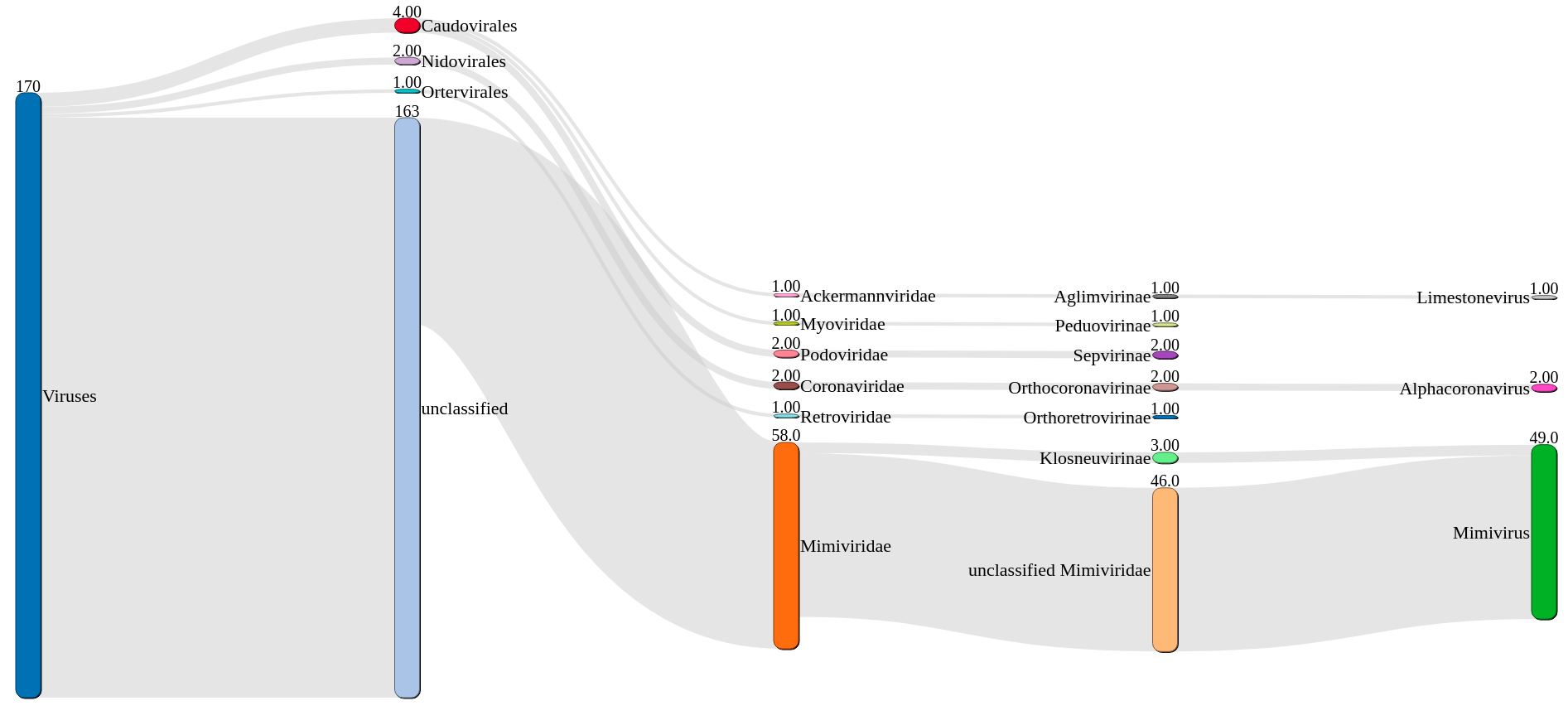VIRify
 VIRify is a recently developed pipeline for the detection, annotation, and taxonomic classification of viral contigs in metagenomic and metatranscriptomic assemblies. The pipeline is part of the repertoire of analysis services offered by MGnify. VIRify’s taxonomic classification relies on the detection of taxon-specific profile hidden Markov models (HMMs), built upon a set of 22,014 orthologous protein domains and referred to as ViPhOGs.
VIRify is a recently developed pipeline for the detection, annotation, and taxonomic classification of viral contigs in metagenomic and metatranscriptomic assemblies. The pipeline is part of the repertoire of analysis services offered by MGnify. VIRify’s taxonomic classification relies on the detection of taxon-specific profile hidden Markov models (HMMs), built upon a set of 22,014 orthologous protein domains and referred to as ViPhOGs.
CWL
VIRify was implemented in CWL.
What do I need?
The current implementation uses CWL version 1.2 dev+2. It was tested using Toil version 4.10 as the workflow engine and conda to manage the software dependencies.
Docker - Singularity support
Soon...
Setup environment
conda env create -f cwl/requirements/conda_env.yml
conda activate viral_pipelineBasic execution
cd cwl/
virify.sh -hNextflow
Email: hoelzer.martin@gmail.com
A nextflow implementation of the VIRify pipeline for the detection of viruses from metagenomic assemblies. The same scripts are used in the CWL and Nextflow implementation.
What do I need?
This pipeline runs with the workflow manager Nextflow using Docker (Conda will be implemented soonish, hopefully). All other programs and databases are automatically downloaded by Nextflow. Attention, the workflow will download databases with a size of roughly 19 GB (49 GB with --hmmextend and --blastextend) the first time it is executed.
Install Nextflow
curl -s https://get.nextflow.io | bashInstall Docker
If you dont have experience with bioinformatic tools and their installation just copy the commands into your terminal to set everything up:
sudo apt-get install -y docker-ce docker-ce-cli containerd.io
sudo usermod -a -G docker $USER- restart your computer
- see more instructions about Docker
Basic execution
Simply clone this repository or get or update the workflow via Nextflow:
nextflow pull EBI-Metagenomics/emg-viral-pipelineGet help:
nextflow run EBI-Metagenomics/emg-viral-pipeline --helpPull and run a certain release:
nextflow run EBI-Metagenomics/emg-viral-pipeline -r v0.1 --helpRun annotation for a small assembly file (10 contigs, 0.78 Mbp) on your local machine (--cores 4; takes approximately 10min + time for database download; ~19 GB on a 8 core i7 laptop):
nextflow run EBI-Metagenomics/emg-viral-pipeline --fasta "/home/$USER/.nextflow/assets/EBI-Metagenomics/emg-viral-pipeline/nextflow/test/assembly.fasta" --cores 4 -profile local,dockerEBI cluster:
source /hps/nobackup2/production/metagenomics/virus-pipeline/CONFIG
# recommended run example to easily resume a run later and to have all run-related .nextflow.log files in the correct folder
OUTPUT=/path/to/output/dir
mkdir -p $OUTPUT
DIR=$PWD
cd $OUTPUT
# this will pull the pipeline if it is not already available
# use `nextflow pull EBI-Metagenomics/emg-viral-pipeline` to update the pipeline
nextflow run EBI-Metagenomics/emg-viral-pipeline --fasta "/homes/$USER/.nextflow/assets/EBI-Metagenomics/emg-viral-pipeline/nextflow/test/assembly.fasta" --output $OUTPUT --workdir $OUTPUT/work $DATABASES --cachedir $SINGULARITY -profile ebi
cd $DIRProfiles
The Nextflow uses the merged profile handling system so you have to define an executor (local, lsf, slurm) and an engine (docker, singularity, conda).
Per default, the workflow is run with Docker-support. When you execute the workflow on a HPC you can switch to
- SLURM (
-profile slurm,singularity) - LSF (
-profile lsf,singularity) and then you should also define the parameters --workdir(here your work directories will be save)--databases(here your databases will be saved and the workflow checks if they are already available)--cachedir(here Docker/Singularity containers will be cached)
The engine conda is not working at the moment until there is a conda recipe for PPR-Meta. Sorry. Use Docker. Please. Or install PPR-Meta by yourself.
DAG chart
A note about metatranscriptomes
Although VIRify has been benchmarked and validated with metagenomic data in mind, it is also possible to use this tool to detect RNA viruses in metatranscriptome assemblies (e.g. SARS-CoV-2). However, some additional considerations for this purpose are outlined below:
1. Quality control: As for metagenomic data, a thorough quality control of the FASTQ sequence reads to remove low-quality bases, adapters and host contamination (if appropriate) is required prior to assembly. This is especially important for metatranscriptomes as small errors can further decrease the quality and contiguity of the assembly obtained. We have used TrimGalore for this purpose.
2. Assembly: There are many assemblers available that are appropriate for either metagenomic or single-species transcriptomic data. However, to our knowledge, there is no assembler currently available specifically for metatranscriptomic data. From our preliminary investigations, we have found that transcriptome-specific assemblers (e.g. rnaSPAdes) generate more contiguous and complete metatranscriptome assemblies compared to metagenomic alternatives (e.g. MEGAHIT and metaSPAdes).
3. Post-processing: Metatranscriptomes generate highly fragmented assemblies. Therefore, filtering contigs based on a set minimum length has a substantial impact in the number of contigs processed in VIRify. It has also been observed that the number of false-positive detections of VirFinder (one of the tools included in VIRify) is lower among larger contigs. The choice of a length threshold will depend on the complexity of the sample and the sequencing technology used, but in our experience any contigs <2 kb should be analysed with caution.
4. Classification: The classification module of VIRify depends on the presence of a minimum number and proportion of phylogenetically-informative genes within each contig in order to confidently assign a taxonomic lineage. Therefore, short contigs typically obtained from metatranscriptome assemblies remain generally unclassified. For targeted classification of RNA viruses (for instance, to search for Coronavirus-related sequences), alternative DNA- or protein-based classification methods can be used. Two of the possible options are: (i) using MashMap to screen the VIRify contigs against a database of RNA viruses (e.g. Coronaviridae) or (ii) using hmmsearch to screen the proteins obtained in the VIRify contigs against marker genes of the taxon of interest.




